We know that both magnesium hydroxide and aluminum hydroxide can be used as flame retardants, so what is the relationship between them? What are the differences? Let’s look at them together.
Flame retardants can be divided into two major categories according to their chemical composition: organic flame retardants and inorganic flame retardants. Organic flame retardants are further divided into two series: phosphorus and halogen, which are gradually being replaced by inorganic flame retardants due to the disadvantages of high toxicity of the decomposition products and high smoke level of the organic flame retardants. Aluminum hydroxide and magnesium hydroxide are the two most important inorganic flame retardants, and their common features are environmentally friendly, flame retardant, smoke suppression and filling function. Aluminum hydroxide is one of the earliest applied inorganic flame retardants. Aluminum hydroxide as a flame retardant is characterized by good stability, non-toxicity, non-corrosive gases, long-lasting flame retardant effect, and high whiteness of the product.
Magnesium hydroxide flame retardant is a kind of inorganic flame retardant being actively developed at home and abroad, it has the above advantages of aluminum hydroxide, its thermal stability and smoke suppression properties are significantly better than aluminum hydroxide, magnesium hydroxide dehydration reaction occurs only at 350 degrees Celsius or above, and magnesium hydroxide’s heat absorption is 17% higher than that of aluminum hydroxide, which also helps to improve the efficiency of the flame retardant, and, at the same time, magnesium hydroxide is more suitable for the processing of At the same time, magnesium hydroxide is more suitable for the processing of high temperature polymers. It can be seen that different flame retardants have different characteristics and uses.

With the increase of polymer processing temperature, aluminum hydroxide is easy to decompose and reduce the flame retardant effect, magnesium hydroxide has the following advantages over aluminum hydroxide:
1️⃣, magnesium hydroxide ranks behind aluminum hydroxide, but because the decomposition temperature of magnesium hydroxide is 110C~140C higher than that of aluminum hydroxide, so it is more suitable for high-temperature thermoplastic plastics processing.
2️⃣, because the thermal decomposition temperature of magnesium hydroxide is higher than that of aluminum hydroxide, so that the plastics added with magnesium hydroxide can withstand higher processing temperatures, which is conducive to speeding up the extrusion speed and shortening the molding time. At the same time, its decomposition ability is higher than aluminum hydroxide, hot melt is also high, help to improve the efficiency of flame retardant.
3️⃣, there is the particle size is smaller than aluminum hydroxide, the abrasion of the equipment is small, which is conducive to prolonging the service life of the processing equipment.
4️⃣, the PH value adjustment of magnesium hydroxide, magnesium hydroxide as a kind of alkali, has the ability to neutralize the acid, but it is a kind of weak alkali compared with the traditional alkali, has a unique buffer ability.
5️⃣, magnesium hydroxide is suitable for slurry products, because of its non-precipitation, non-suspicious polymerization, better mobility, easy to pump and store, easy to use and adjust the control.
6️⃣, Aluminum hydroxide is the inorganic flame retardant additive with larger dosage and wider application. Aluminum hydroxide as a flame retardant can not only flame retardant, but also can prevent fuming, does not produce droplets, does not produce toxic gases, therefore, to obtain a wider range of applications, the amount of use is also increasing year by year. Scope of use: thermosetting plastics, thermoplastics, synthetic rubber, coatings and building materials and other industries.
7️⃣, magnesium hydroxide as an additive inorganic flame retardant, with good thermal stability, non-toxic, smoke suppression, high efficiency to promote the role of the substrate into charcoal, and does not produce corrosive gases at the same time also has the function of neutralizing the acidic and corrosive gases produced in the process of combustion, as a kind of environmentally friendly green flame retardant has a very good market outlook. However, the dispersion and compatibility of magnesium hydroxide in polymer materials are poor, which often leads to a decrease in the mechanical properties of flame retardant materials. Therefore, how to increase the compatibility between magnesium hydroxide and polymers and reduce its use has become a problem to be solved.
Aluminum hydroxide and magnesium hydroxide have their own advantages and scope of use, although they can be used as flame retardants, but because of the difference between the two, so the choice should be based on the specific requirements of the use of the corresponding properties to choose.

